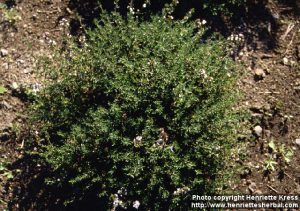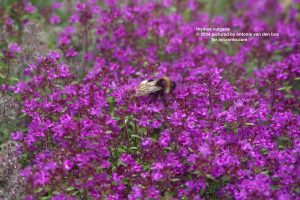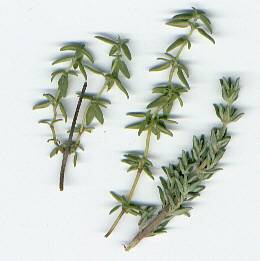(Thymus vulgarus)
- Alias names for Thyme: Family—Lamiaceae, Garden thyme, English broadleaf thyme
- Chinese Names for Thyme: None found
Pictures of Thyme:
References for Thymus vulgaris pictures. Thymus vulgaris flowers can be white or purple.
- Thyme plant: www.lisashea.com/garden/herbs/thyme
- White flowers: https://www.henriettesherbal.com/pictures/p13/pages/thymus-vulgaris-1.htm
- Thyme sprigs: https://www.uni-graz.at/~katzer/engl/Thym_vul.html
It’s About Thyme: Thyme culinary spice is widely used with poultry, beef, in soups, stuffing’s, marinades, casseroles, baked or sautéed vegetables. Its dried leaves are often included in potpourris and moth-repellent sachets. Thyme has been noted as a strengthener of the lungs, and the best remedy for whooping cough. It is an excellent antiseptic and tonic and is still used today as a respiratory remedy and for a variety of other ailments. Fresh thyme leaves have an aromatic, slightly bitter taste.
Historical Medicinal Uses of Thyme and How it Works:
- Aches and pains
- Arthritis
- Asthma
- Bronchitis
- Common cold (in hot infusion to cause sweating)
- Depression
- Diarrhea and enuresis (bed wetting) in children
- Dry coughs—helps to control
- Ease flatulence
- Ease rheumatic pain (external applications)
- Excess bronchial mucus
- Exhaustion
- Expels worms; especially hookworms and roundworms
- Expectorant
- Fungal infections
- Gastritis
- Gingivitis (Thyme in toothpaste)
- Improves digestion
- Indigestion
- Infected gums
- Laryngitis
- Peptic ulcer
- Relaxes spasms
- Shingles
- Skin and scalp complaints
- Sooth digestive system
- Sore throat
- Supports normal body function/counters effects of aging
- Tonsillitis
- Upper respiratory tact infections
- Whooping cough
Parts of Thyme Plant Used: Dried or partially dried leaves and flowering tops.
Properties of Thyme: Thyme is an aromatic warming astringent herb. It is strongly antiseptic and antifungal.
Chemical Constituents of Thyme: Volatile oil (phenol, thymol, carvacrol), monoterpene hydrocarbons (terpinene), and alcohols (linalool), tannin, flavonoids and saponins.
Contraindications, safety issues, concerns, harmful drug interactions and allergy precautions for Thyme: While thyme herbal preparations are considered generally very safe, the isolated volatile oil is toxic and should not be used internally. Thyme oil is for topical use only. Taken internally it may lead to dizziness, vomiting, and breathing difficulties. Some experts feel pregnant or lactating women should avoid using thyme in any form.
Other Notes for Thyme: Thyme grows best in well drained soils. It benefits from a layer of gravel to protect the foliage from contact with wet soil. Thyme is hardy to 5’F (-15’C). Propagate by seed in spring, by stem cuttings in summer, or by division in spring or late summer. Established plants may be pruned quite hard in early spring, or lightly after flowering. Thyme vulgaris is used in companion planting to control flea beetles, and a variety of pests on cabbage. Whole plants and flowering tops may be harvested as flowering begins in summer and distilled for oil, or dried for elixirs, liquid extracts and infusions. Sprigs are picked during the growing season and used fresh or dried for infusions.
Helpful Links and References for Thyme:
These products are not drugs, but foods for special dietary use pursuant to applicable Federal law. No statement in this page shall be construed as offering these products for the diagnosis, cure, mitigation, treatment, or prevention of any disease.
Related Pages:



